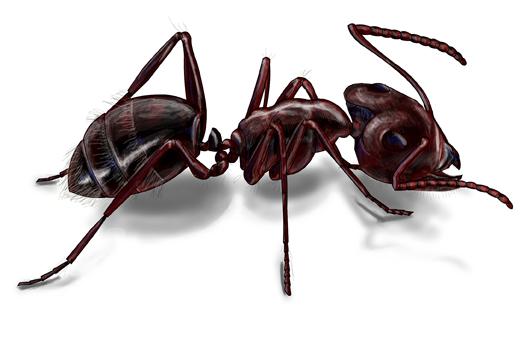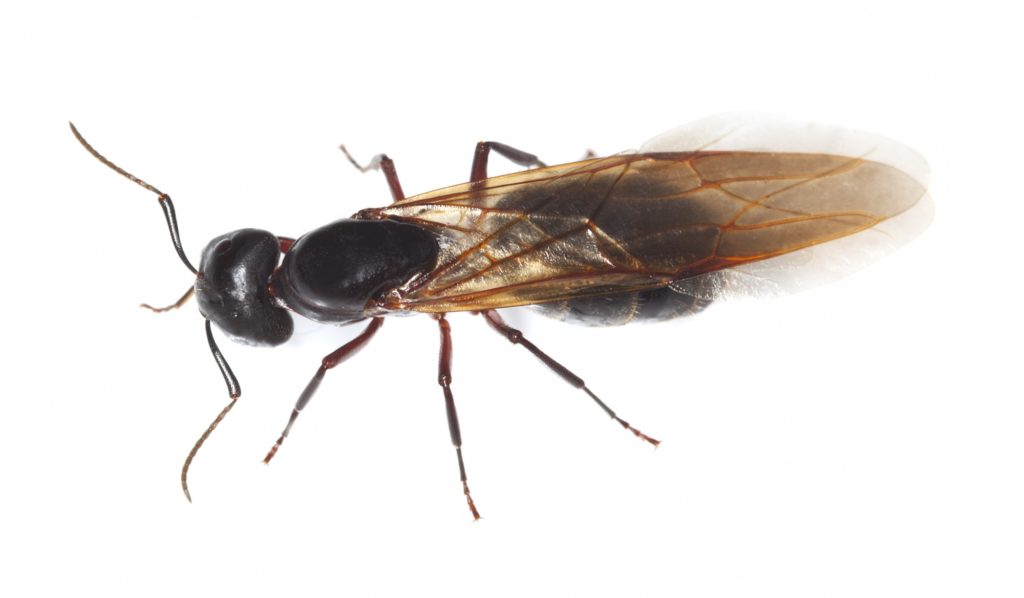Carpenter ants are a type of pest easily mistaken for termites because of their wood-boring behaviors. A larger species of ant, they burrow into wooden structures, similar to termites, and can cause damage to property in a similar way to termites. Here’s what you need to know about the kind of effects a carpenter ant infestation can have on your home.
Carpenter ants have been known to occasionally bite humans and they do have extremely powerful jaws for their size. Once bitten you’ll feel a pinch and then some minor irritation to the bite site.
That being said, carpenter ants are extremely dangerous when it comes to structural damage. Their whole life revolves around biting and chewing moist and soft wood, which if your home seems tasty to them, then they’re going to put some damage in. Unlike termites, carpenter ants do not eat wood—they simply chew it with their mandibles and discard it as waste. One of the largest species of ants, these pests are also the most problematic because of how much structural damage they can wreak.

Carpenter ants belong to the genus Camponotus and are “polymorphic.” This means that there are workers of varying sizes in the colony. Carpenter ant workers have black, dark brown, red and black, yellow or red coloration with sizes ranging from 3.4 to 13 mm.
Several species of carpenter ants exist within the United States, so size and color are not always reliable identifying characteristics. Carpenter ants are distinguished from other species by the rounded profile of their thorax, the heart-shaped head and circle of hairs around the anus. (These identifying characteristics are best seen under magnification.)
When a carpenter ant nest reaches its maximum population, it will begin to produce male and female reproductives. These are the winged ants we call swarmers. And swarmers have one purpose. Their job is to establish a new nest. That means your carpenter ant problem is about to become worse.

Carpenter ants need a water source to survive, which is one reason why the primary kind of wood they target is dead, rotting, or damp. It’s easier to dig into and provides them with a source of moisture. Outdoors, they may be found creating nests in tree stumps, fence posts, firewood, or landscaping. Indoors, they may be found digging into damaged windows and door frames, crawlspaces, attics, chimneys, sinks, bathtubs, and old wooden siding.
Since carpenter ants are larger insects, the damage they create may be more obvious and more destructive. They regularly leave their nests to forage and return to continue digging. If you find small but obvious holes in wood on your property that appear to be tunnels, especially if it looks like a small pile of sawdust is collecting under them, you may have discovered a carpenter ant infestation.
A carpenter ant infestation within a building usually means that there is a moisture problem. For instance, these critters are often found around dishwashers, sinks, laundry areas, and bathrooms – especially where plumbing leaks. Taking care of the source of that moisture makes the structure less attractive to the ants.
Tips for preventing carpenter ant infestations:
- Caulk any cracks you find to eliminate entrance paths
- Caulk around electrical and water lines where carpenter ants could enter the building
- Trim branches near your home or office so that they aren’t touching it. This keeps ants from using the branches as a pathway
- Consider installing a gravel or stone strip around your home
- Store firewood away from your house and up off the ground
- Check for signs of ants before bringing firewood inside
- Store food in tightly sealed containers and clean the kitchen regularly
- Clean clogged gutters in order to prevent water damage
- Remove logs, stumps, and wood near or under the structure
- Make sure crawl spaces and attics are well ventilated
- The wooden parts of porches and decks should not be in contact with the ground. Use concrete pier blocks underneath these to eliminate other possible entrance paths
- Immediately fix any leaks in the roof or plumbing pipes
When left untreated, carpenter ant damage can be significant. It is never a good idea to let an infestation go untreated. If you’re seeing worker ants or swarmers in or around your property, and you live in the greater Triad service area, reach out to The Best Pest Control Solutions to stop those wood-destroying pests in their tracks.

